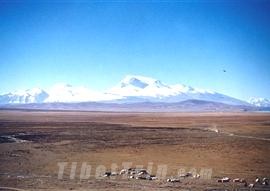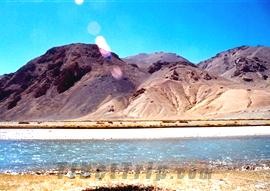 'The most beautiful scenery lies on the perilous peaks of a mountain' (from the poem 'Qijue' by Mao Zedong (1893-1976)). It is hard to imagine what transcendent beauty is presented in Ngari, the highest point on the Qingzang (Qinghai-Tibet) Plateau, the pinnacle of the 'roof of the world', and what hardships one must overcome to reach it.
The majestic mountain ranges of Himalayas, Gangdise and Kunlun span this vast region, covering a total area of about 340,000 square kilometers (131,274 square miles), approximately 1/4 of the entire Tibet region. Four rivers, in the shape of a lion, a horse, a peacock and an elephant, and by which the names of the rivers were derived, wind through the Ngari region and are believed to be the sources of the Indus River, the {{Yarlung Tsangpo River|/features/yarlong.htm}} , the Ganges River and the Sutlej River respectively.
It is the western part of Tibet, bordering India and Nepal to the south, India-administrated Kashmir to the west and Xinjiang Autonomous Region to the north. At an average attitude of 4,500m (14,764 ft), the Ngari region is sparsely populated. Only about 70,000 inhabitants occupy seven counties of this region, namely, Gar, Purang, Rutog, Zanda, Gegye, Gertse and Tsochen.
Snow-covered mountains encompass the Ngari region, with sparkling blue lakes scattered among its green plateaus. Even with its harsh climate and vertiginous altitude, the Ngari region is nevertheless an amazing landscape which bears a unique, wild and undisturbed beauty. Endowed with more than 80 rivers, 60 lakes and utilizable pastures as wide as 19 million hectares (approximately 44 million acres), the Ngari region is not only abundant in mineral and geothermal resources but home to rare flora and fauna as well.
'The most beautiful scenery lies on the perilous peaks of a mountain' (from the poem 'Qijue' by Mao Zedong (1893-1976)). It is hard to imagine what transcendent beauty is presented in Ngari, the highest point on the Qingzang (Qinghai-Tibet) Plateau, the pinnacle of the 'roof of the world', and what hardships one must overcome to reach it.
The majestic mountain ranges of Himalayas, Gangdise and Kunlun span this vast region, covering a total area of about 340,000 square kilometers (131,274 square miles), approximately 1/4 of the entire Tibet region. Four rivers, in the shape of a lion, a horse, a peacock and an elephant, and by which the names of the rivers were derived, wind through the Ngari region and are believed to be the sources of the Indus River, the {{Yarlung Tsangpo River|/features/yarlong.htm}} , the Ganges River and the Sutlej River respectively.
It is the western part of Tibet, bordering India and Nepal to the south, India-administrated Kashmir to the west and Xinjiang Autonomous Region to the north. At an average attitude of 4,500m (14,764 ft), the Ngari region is sparsely populated. Only about 70,000 inhabitants occupy seven counties of this region, namely, Gar, Purang, Rutog, Zanda, Gegye, Gertse and Tsochen.
Snow-covered mountains encompass the Ngari region, with sparkling blue lakes scattered among its green plateaus. Even with its harsh climate and vertiginous altitude, the Ngari region is nevertheless an amazing landscape which bears a unique, wild and undisturbed beauty. Endowed with more than 80 rivers, 60 lakes and utilizable pastures as wide as 19 million hectares (approximately 44 million acres), the Ngari region is not only abundant in mineral and geothermal resources but home to rare flora and fauna as well.

Mysteriously attractive, it boasts Mt. Kailash and Lake Manasarovar, the 'Sacred Mountain and Holy Lake' venerated by Buddhists, Hindus, Jains and followers of Bon, the indigenous religion of Tibet. Believed to be the 'center of the world' by Buddhism, the awe-inspiring Mt. Kailash, accompanied by the harmoniously placid Lake Manasarovar, is not only the lifelong dream of pilgrims but an irresistible attraction to travelers. The Ruins of Guge Kingdom, records the splendor and opulence enjoyed within the Guge Kingdom, which mysteriously drew an end to its 700-year history by disappearing completely in the 17 th century.
Inaccessible as it used to be, the Ngari region can now be reached from Lhasa , Xinjiang Autonomous Region and Nepal. The town of Shiquanhe, where the Administrative Office of Ngari Prefecture is seated, is the largest town in western Tibet, as well as the place where one can get supplies of traveling necessities and rest prior to your exhilarating Ngari expedition.








